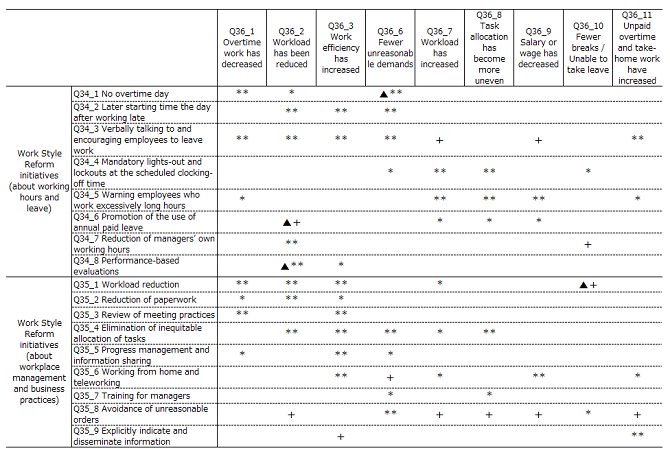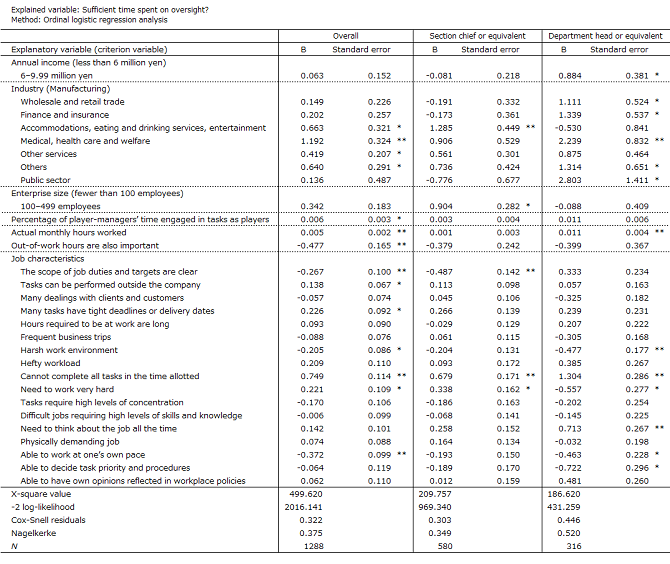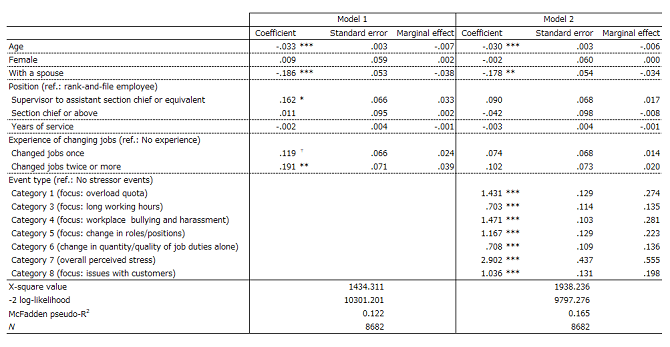JILPT Research Report No.217
Study on Working Hours: Analysis of Individual Survey Results
March 31, 2022
Summary
Research Objective
With a focus on working hours, this research reveals the current state of working conditions, workers’ health, and workplace management administered by managers. Based on the discussions, we analyzed how working hours and workplace management should be, how overwork could be prevented, and how workers’ health could be ensured for measures.
Research Method
Secondary analysis of survey results conducted to individuals
Key Findings
In Chapter 2, as the first one of the individual analyses, “Analysis of Factors Affecting Working Hours and Work Styles,” the study examines the impact on working hours of different types of working-hour systems for regular employees and various ascriptions of managers. It also explores how Work Style Reform initiatives have changed job duties and work styles in Japan.
Regarding working-hour systems, workers whose schedules involve discretionary work (“discretionary working-hour system), etc., or workers in managerial positions have longer working hours than those with ordinary work schedules (“standard working-hour system). Superficial “flexibility” of work schedules was found to increase working hours, indicating that these schedules are not very flexible.
Ascriptions associated with managerial positions were not found to have a clear and significant effect on working hours. However, the results indicate that many managers work longer hours than non-managers.
Among Work Style Reform initiatives, favorable results were observed for “later starting times the day after working late,” “reduction of paperwork,” “review of meeting practices,” and “progress management and information sharing.” On the other hand, in some cases about “no overtime day,” “verbally encouraging employees to leave work,” “mandatory lights-out times and building lockouts to prevent overtime work,” “warning employees who work excessively long hours,” “reduction of managers’ own working hours,” “performance-based evaluations,” “workload reduction,” “elimination of uneven task allocation,” “working from home and teleworking,” “training for managers,” and “avoidance of unreasonable orders,” the effect was the opposite of what was intended by Work Style Reform depending on how reforms are implemented and the actual situation on the ground (Table 1).
Table 1. Summary of the impact of Work Style Reform initiatives (Q34, Q35) on job duties and work styles (Q36)

- Notes:1. From the Results of Survey on Work and Health of Employees, and Managers’ approach to Workplace Management, Research Series no.222, (JILPT 2020 survey), the scope of analysis is limited to regular employees.
- 2. Results from Table 2-5-1 through Table 2-5-9 are summarized.
- 3. ** indicates statistical significance at less than 1%, * at less than 5%, and + at less than 10%. Negative coefficient values are marked with ▲.
Chapter 3, “Factors Contributing to the Managers’ Time Insufficiently Spent on Workplace Oversight,” analyzes key factors contributing to the lack of time spent on workplace management in terms of the current situation and challenges managers face in organizations.
Overall, the key factors observed as affecting insufficient time for managers to oversee are excessive overall workload and failure to allocate workload appropriately to personnel. In particular, managers fail to adjust their own workload and that of subordinates’ workload; they take on work that subordinates cannot handle; and they control consciously the insufficient time for oversight. Effective training of subordinates is seen as key to increasing workplace productivity as well as the amount of time managers can devote to oversight (Table 2).
Table 2. Factors contributing to the insufficient time for oversight (by job characteristics)

- Notes: 1. ** indicates significance at the 1% level, and * significance at the 5% level.
- 2. For variables in the basic model, significance is shown only for results.
Chapter 4, “Workplace Management and Working Hours,” examines several aspects of workplace management that seem essential when considering the issue of working hours and their distribution and trends, especially with the length of actual hours worked(for the month of October 2020). The issues discussed are (i) attendance oversight, (ii) Article 36 agreements (called Saburoku-Kyotei by which limits on overtime work are waived under Article 36 of the Labor Standards Act (LSA)), (iii) overtime (work exceeding prescribed hours), (iv) workplace oversight by managers, (v) how overtime is determined and paid (fixed overtime pay system by employment contract), and (vi) workers’ attitudes toward work and life.
Whether or not there is management on clocking in and out of workers, and what procedures are used for it, have not affected the length of working hours. Appropriate oversight (monitoring of the times workers enter workplaces and leave) on this and the records of hours worked by such procedures conducted eventually need to be used to curb excessive working hours and overwork.
The length of overtime hours stipulated by “Article 36 agreements” may increase the length of working hours (Table 3). It is essential that Article 36 agreements must be appropriately administered.
Table 3. Cross-tabulation of the length of overtime hours stipulated by “Article 36 agreement” (standard) (Q22SQ_1) categories and actual hours worked categories (Q15.October 2020)

- Note: Responses of 101 hours or more were excluded from the question on the number of fixed overtime hours.
The reasons for overtime work depend on the effectiveness of managers’ work management and the workers’ attitudes. There is a need for more appropriate work management by managers and adjustment of workers’ attitudes.
Managers’ instructions to their subordinates determine the length of their subordinates' working hours. Appropriate workplace management by managers is vital.
The length of overtime hours corresponding to the overtime pay covered by the fixed-overtime pay system may also affect the length of working hours. An appropriate number of overtime hours should be set as part of the practical management of working hours (Table 4).
Table 4 Cross-tabulation of fixed overtime-hours categories (Q21SQ) and actual hours worked categories (Q15. October 2020)

- Note: Responses of 101 hours or more were excluded from the total on the number of fixed overtime hours.
Workers’ attitudes toward their jobs and lives determine the length of their working hours. Thus, a change in workers’ attitudes against overtime is necessary.
Chapter 5, “Workload concerning Mental Health,” examines the relationship between workload and mental health problems.
Mental health problems are related to things experienced on the job, such as long working hours, excessive quotas, and harassment by those in superior positions, and customer complaints. These experiences can cause psychological stress by themselves, or they can become stressors when experienced in combination with other occurrences. Concerning these reasons, we constructed a typology of work-related experiences, or eight types of “events” which included the “no work-related stress events” type. The impact of stressful experiences on mental health was then examined.
In addition to ascriptions such as age, occupational characteristics –– by industry and type of job, and career characteristics –– job title and experience of changing jobs, are related to the presence and content of work-related stressors as seen in the experience (eight types of events, mentioned above). In particular, it was observed that young people, those in the position of supervisor to assistant section chief or equivalent and those who had changed jobs more than once were more likely to experience certain stressful events. Mental health status also varies depending on age, job title, and experience of changing jobs, which was partly explained by the fact that people with those specific factors are more likely to have highly stressful experiences at work (Table 5).
Table 5. Determinants of mental health (K6 score of 5 or higher)

- Note: Robust standard errors are indicated with: ***p<.001; **p<.01; *p<.05; p<.10.
Policy Implications
Flexible work schedules do not enable flexible work styles but rather increase actual hours worked compared to other types of work schedules. This fact underscores the importance of overseeing work quantity and quality as well as the status of job performance.
Work Style Reform which aimed at improving the working environment may not achieve the desired objectives, depending on the issues included in the reforms or related problems. Elaborate attention must be paid to how these issues are handled and how they relate to other issues introduced concurrently, in line with business and workplace conditions.
The actual working hours of managers, especially middle-level managers such as kacho (section chiefs) and bucho (department heads), are relatively long compared to those in other positions. While their positions require them to “coach others” and “play on the team” at the same time, it is necessary for them to adjust their workloads and assign appropriate personnel to accommodate what they cannot handle by themselves. For this overloaded work to be completed, it is necessary to consider giving managers authority over personnel and budgets. In addition, enterprises’ consideration for effective training of subordinates (younger employees) can also contribute to reducing workload and actual working hours.
From the perspective of workplace management, the following points can be made: the time when workers enter and leave the workplace should be properly managed; Article 36 agreements should be appropriately implemented; managers should properly instruct department members on their tasks, oversee said tasks, and change department members’ mindset as needed. Additionally, as the length of overtime hours corresponding to the overtime pay covered by a fixed-overtime-pay system may affect the actual hours worked, the number of overtime hours must be set at an appropriate level.
Mental health is not only related to work but also to other factors, such as lifestyle habits and personality traits; it is challenging to manage one’s work when it overlaps with personal life and privacy. Work-related stress factors play crucial roles in mental health, and reducing occupational stress is essential for workers’ health. Also, in discussions of overwork, the focus tends to be on long working hours, but the workload’s impact on mental health is not limited to the length of working hours. There is an urgent need to pay sufficient attention to various other workload factors and to make changes to working environments that may be detrimental to workers’ health.
Contents
JILPT Research Report No.217, full text(PDF:4.6MB) [in Japanese]
Research Period
April 2021–March 2022
Authors
- IKEZOE Hirokuni
- Assistant Research Director, The Japan Institute for Labour Policy and Training
- OGURA Kazuya
- Professor, Faculty of Commerce, Waseda University
- FUJIMOTO Takashi
- Research Associate, The Japan Institute for Labour Policy and Training
- TAKAMI Tomohiro
- Vice Senior Researcher, Japan Institute for Labour Policy and Training
Category
Working conditions / Work environment
For Citation
JILPT. 2022. Rodo jikan no kenkyu: Kojin chosa kekka no bunseki [Study on working hours: Analysis of individual survey results]. JILPT Research Report no.217. Tokyo: The Japan Institute for Labour Policy and Training.
Related Research
- JILPT Research Report No. 106, Research Study on Diversification of Working Places and Working Hours (2009) (PDF:332KB)
- JILPT Research Report No. 128, Work Characteristics, Personal Characteristics, and Working Hours (2011) (PDF:147KB)
- Research Series No. 222, Results of Survey on Work and Health of Employees, and Managers’ Approach to Workplace Management (2022)
- Research Material Series No. 254, Interview Survey with Managers: Managers’ Working Styles and Workplace Management (2022)
JILPT Research Report at a Glance
| To view PDF files, you will need Adobe Acrobat Reader Software installed on your computer.The Adobe Acrobat Reader can be downloaded from this banner. |

